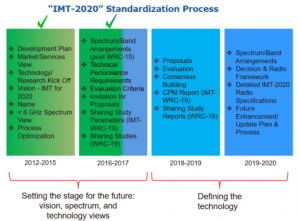The Future of 4G Mobile Technology in the UK
What is 4G?
Mobile telephony has developed through several generations. The first generation (1G) was analogue, allowed for voice data only and used frequency-division multiple access.
The second generation (2G) is known as GSM. (Global System for Mobile). It was digital and initially focused on voice. GSM was a standard developed in the 1980s by the Conference of European Postal and Telecommunications Administrations.
The third generation (3G) system used in the UK is digital and called the Universal Mobile Telecommunications system (UMTS) also known as IMT-2000 (International Mobile Telecommunications). It was designed for voice and data and produced in the 1990s by the International Telecommunications Union (ITU).
The fourth generation (4G) is part of a project by the 3rd Generation Partnership Project (3GPP) to further develop UMTS. The 3GGP issued releases which updated and enhanced UMTS. Releases 7 and 8 are known at Long Term Evolution (LTE) for UMTS. It is an IP based system
By 2010 the ITU had reached a finalised version of the IMT-Advanced standard introduced in Release 10. This included two technologies called LTE Advanced and WiMAX 2.0. “These were classed as 4G technologies where LTE has also been accepted as being and is referred to as 4G technology.” (The Open University, 2017)1
Differences between 4G and HSPA
HSPA (High Speed Packet Access) is a widely deployed and widely popular mobile broadband technology within the GSM family of technologies. HSPA encompasses both HSDPA (3GPP Release 5) and HSUPA (3GPP Release 6) technologies, when they are deployed on a network.
4G incorporates of a number of techniques and technologies that build and improve on earlier network standards like HSPA. The main differences between 4G and HSPA are below.
- HSPA covers releases 5 and 6 of the UMTS standard. 4G comes under releases 7 to 14 currently.
- HSPA can be informally classed as 3.5G technology rather than 4G.
- HSPA is a digital system where as 4G is an IP-based system.
- HSPA has a maximum downlink speed of 14.4Mb/s and a maximum uplink speed of 5.7Mb/s. 4G has a maximum of 1Gb/s downlink speed and a maximum uplink speed of 500Mbs with LTE-Advanced moving towards 3 Gbit/s downlink and 1.5 Gbit/s uplink.
- 4G requires a complete redesign and simplification of 3G network architecture. Building a 4G network requires a completely new environment.
- 4G has a lower latency than HSPA and better quality of service. 4G has a round trip time of around 10ms however HSPA is less than 100ms.
- HSPA builds upon third generation UMTS/WCDMA technology with IMS (IP Multimedia System) and MBMS (Multimedia broadcast and multicast services) however, 4G uses OFDMA (orthogonal frequency-division multiple access) along with MIMO (multiple-input multiple-output).
- HSPA uses scheduled shared channel transmission and channel dependent scheduling where capacity gains are obtained by transmitting to users with less busy radio-link conditions. This is known as multi-user diversity. 4G increases capacity by using time-division multiplexing technology on OFDMA to allow different users to share blocks of 12 channels.
Some technical details about 4G
The IMT-Advanced Standard was finalized in 2010 by the ITU. Two technologies are compatible with IMT-Advanced, and are therefore 4G technologies. One is LTE Advanced and the other Mobile WiMAX 2.0.
- LTE Advanced
LTE Advanced was introduced in the 3GPP’s Release 10. The 3GPP Group have advised of the following features.
- Peak downlink speeds of 1 Gbp/s and uplink 500 Mbps.
- Three times greater spectrum efficiency than LTE with a peak spectrum efficiency downlink of 30 bps/Hz and uplink of 15 bps/Hz.
- Scalable bandwidth use and spectrum aggregation where non-contiguous spectrum needs to be used. This enables an increase in peak user data rates and overall capacity of networks by aggregating the bandwidth of component carriers.
- 5ms or less of latency
- Cell edge user throughput to be twice that of LTE.
- Average user throughput to be 3 times that of LTE.
- Mobility the same as LTE
- Backward compatible with legacy systems
The technologies used in LTE-Advanced to enable these features are as follows
- OFDMA (orthogonal frequency-division multiple access). The frequency band is split into a large number of closely spaced carriers called sub-carriers. Users are allocated to a number of channels and then a number of sub-carriers spaced at 15kHz. The downlink will use OFDMA and the uplink will use SC-FDMA. (Single channel frequency-division multiplex access)
- MIMO (multiple-input multiple-output) By using multiple antennas at the transmitter and receiver, MIMO enables the system to set up multiple data streams on the same channel, increasing the data capacity of a channel
- Relay Nodes are low power base stations that provide enhanced coverage and capacity at cell edges, and hot-spot areas.
- Coordinated Multipoint is used to improve poor performance at the cell edges.
- Device to Device (D2D) is a peer to peer link which allows devices to communicate directly with one another in close proximity
WiMAX
WiMAX stand for Worldwide Interoperability for Microwave Access. WiMAX technology is a broadband wireless data communications technology based around the IEE 802.16 standard providing high speed data over a wide area (up to 50 km) between fixed sites. IEEE 802.16m is now described as a 4G technology, as well as IEEE 802.16m. IEEE 802.16m is IP-based and packet-switched and is an alternative to wire technologies (Cable Modems, DSL and T1/E1 links) 802.16m can provide data rates up to 100 Mbps and the cell radius distances are typically between 20 and 30 miles.
The technologies used for WiMAX are
- OFDM (Orthogonal Frequency Division Multiplex). IEEE 802.16m uses more closely spaced subcarriers than LTE Advanced. “In addition, whereas IEEE 802.16m uses OFDMA in both the uplink and the downlink, LTE Advanced, like LTE, uses it only in the downlink.” (Open University, 2017)2
- MIMO (Multiple Input Multiple Output): WiMAX makes use of multipath propagation using MIMO. By utilising the multiple signal paths that exist, the use of MIMO either enables operation with lower signal strength levels, or it allows for higher data rates
An update on 4G in the UK
The framework of standards for International Mobile Telecommunications (IMT), encompassing IMT-2000 and IMT-Advanced covering 3G and 4G technologies will continue to evolve as 5G with IMT-2020, a programme to develop “IMT for 2020 and beyond” by the ITU-R (International Telecommunication Union for Radio)
A draft new report is expected to be finally approved by the ITU-R Study Group 5 at its meeting in November 2017. “The next step is to agree on what will be the detailed specifications for IMT-2020, a standard that will underpin the next generations of mobile broadband and IoT connectivity,” said François Rancy, Director of ITU’s Radiocommunication Bureau.” (ITU, 2017)1
Figure 1 (ITU, 2017)2
Conclusion
The ITU has been continually developing the mobile communicating standards, specifications and features for 30 years. IMT2020/5G looks set to provide an enhanced service providing better coverage, lower outage probability, higher versatility and scalability, higher peak downlink and uplink speeds, higher spectral efficiency and the support of new trends such as IoT (Internet of Things). The technologies are still being defined but it looks like great improvements will be made to support the growing network of devices worldwide.
References
The Open University (2017)1, ‘4G’, T215 Block 2 Part 6 Convergence and 4G [online]. Available at: https://learn2.open.ac.uk/mod/oucontent/view.php?id=1102783§ion=4. (Accessed 1 December 2017)
The Open University (2017)2 ‘Mobile WiMAX’ [online]. Available at: https://learn2.open.ac.uk/mod/oucontent/view.php?id=1102783§ion=4. (Accessed 1 December 2017)
ITU (2017)1, ‘ITU agrees on key 5G performance requirements for IMT-2020’ [online]. Available at: http://www.itu.int/en/mediacentre/Pages/2017-PR04.aspx [Accessed 3 December 2017]
ITU (2017)2, “IMT-2020” Standardization Process [online]. Available at: http://www.itu.int/en/mediacentre/Pages/2017-PR04.aspx [Accessed 3 December 2017].



